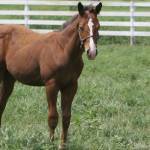Wobbler Syndrome in Horses

Horses with wobbler syndrome usually start life with no obvious problems. As they grow, however, these horses gradually develop uncoordinated gaits, stumbling, dragging a limb, swaying as they walk, or other similar signs. A young wobbler could seem just a bit clumsy when he walks, and might avoid running and playing with his pasturemates. Typically these horses don’t seem to be sick. They have a good appetite and are aware, responsive, and interested in their surroundings, with the development of gait irregularity being the only sign of a problem.
Wobbler syndrome is the common term for cervical vertebral myelopathy, a condition in which the spinal cord becomes compressed because of a narrowing or instability affecting one or more vertebrae. Pressure on the spinal cord causes irritation and swelling of the spinal cord. The condition develops slowly, and early signs may be missed.
In young horses, wobbler syndrome is found in males more often than females and may be related to fast growth of large, heavy youngsters. Thoroughbreds, Quarter Horses, and Warmbloods are affected more frequently than some other breeds. Radiographs are sometimes used to detect narrowed areas in the neck vertebrae. Use of dye in the spinal canal helps to increase contrast to show deformities more clearly in an x-ray (myelogram). Young horses diagnosed with wobbler syndrome are sometimes stalled to prevent further injury from roughhousing with their pals, and their diets are modified to slow overly rapid growth. If the syndrome is diagnosed before a young horse is a year old, these measures, coupled with anti-inflammatory medications, can often limit damage to the spinal cord. Affected horses have a fair chance of going on to useful lives if they are diagnosed and treated from an early age.
An injury to the neck or spine can precipitate signs of wobbler syndrome in a horse of any age. Young horses wrestle, twist, and sometimes fall as they play with their herdmates, and spinal injuries can result.
When a similar problem occurs in older horses, the rider will notice that the horse becomes increasingly reluctant to jump, turn sharply, or make a smooth transition to faster gaits. Rather than developing as the horse’s skeleton grows and matures, pressure on the spinal cord in older horses may follow injuries, falls, or arthritic changes in the vertebrae. Surgery to stabilize the spine by fusing two or more vertebrae can improve the lives of some older horses with spinal cord compression. The surgery doesn’t help every horse, though some improvement can be expected in most animals selected for this treatment.
There is some evidence of a genetic component in wobbler syndrome. Research is ongoing to determine what the connection may be.








